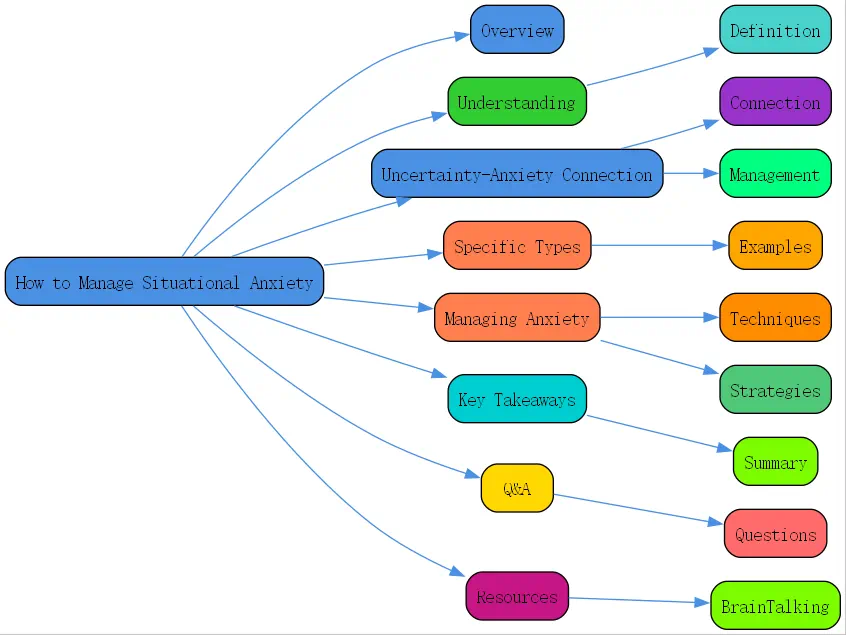Learn how to manage situational anxiety effectively with practical strategies, from dealing with driving anxiety to managing ADHD anxiety.
How to Manage Situational Anxiety: A Comprehensive Guide

Anxiety is a natural response to uncertainty, but it can feel overwhelming when it affects your daily life. Situational anxiety, a form of anxiety triggered by specific events or social interactions, is particularly common and manageable when approached with the right tools and strategies. BrainTalking, a trusted resource for mental health and psychology expertise, delves into how to manage situational anxiety effectively, whether you’re struggling with ADHD-related anxiety, driving anxiety, or other situational stressors.
Understanding Situational Anxiety
Definition of Situational Anxiety
Situational anxiety arises when certain events or circumstances trigger feelings of fear, uneasiness, or apprehension. Unlike generalized anxiety, situational anxiety is tied to specific situations, such as public speaking, social gatherings, or interacting with strangers. These moments often bring uncertainty, which can snowball into feelings of discomfort and anxiety.
Common Triggers and Situations
Situational anxiety can emerge in a variety of contexts. Interactions with strangers, whether at work, school, or in public spaces, are a common cause, as outlined in the Uncertainty-Anxiety Management Theory. Driving anxiety, test-taking pressure, or dealing with deadlines are other frequent triggers that heighten feelings of unease.
The Difference Between Situational and Generalized Anxiety
While both types of anxiety cause distress, situational anxiety tends to be short-term and closely tied to specific events. Generalized anxiety, on the other hand, manifests as persistent worry across multiple areas of life without being linked to particular situations. Understanding this difference is crucial, as situational anxiety often requires targeted techniques for resolution.
The Uncertainty-Anxiety Connection and Management Techniques
The Role of Uncertainty in Causing Anxiety
Uncertainty often serves as the foundation for situational anxiety. When we are unsure about a situation, person, or outcome, our ability to predict or understand the behaviors and feelings of others diminishes. According to the Uncertainty-Anxiety Management Theory developed by Gudykunst, uncertainty in interactions鈥攅specially with strangers鈥攃reates anxiety because we lack familiarity or shared cultural understanding.
For example, engaging in intercultural communication can amplify anxiety due to differences in behavior, norms, and expectations. This is particularly pronounced during initial interactions, where unfamiliarity may lead to discomfort. However, as familiarity develops, uncertainty and anxiety tend to decrease.
Practical Strategies for Managing Uncertainty and Anxiety
Managing situational anxiety involves reducing uncertainty through proactive and mindful strategies:

1. Education and Preparation: Familiarize yourself with the situation or people involved. For example, before a presentation or meeting strangers, research the topic or social dynamics to reduce unpredictability. 2. Mindfulness: Practicing mindfulness helps anchor you in the present moment, curbing overthinking and fear of unknown events. Techniques such as deep breathing, meditation, or grounding exercises can be especially effective. 3. Exposure Therapy: Repeated exposure to anxiety-provoking stimuli can gradually lessen your fear. Interacting more often with strangers or engaging in activities that make you uneasy builds confidence over time. 4. Effective Communication: The Uncertainty-Anxiety Management Theory emphasizes that mindful communication can mitigate both anxiety and uncertainty. Active listening, showing empathy, and asking clarifying questions help establish understanding and trust.
Mindfulness and Effective Communication
Mindfulness is not only a tool for reducing situational anxiety but also pivotal for improving communication skills. By being fully present in the moment and focusing on the interaction at hand, you can reduce distractions caused by anxiety and engage more effectively. Gudykunst highlights that reducing uncertainty is the first step to suppressing anxiety during conversations. Techniques such as maintaining eye contact, attentive listening, and practicing patience ensure smoother interactions with strangers.
Managing Specific Types of Situational Anxiety
Situational anxiety is not a one-size-fits-all experience, and approaches to managing anxiety differ based on triggers. Below, we discuss actionable strategies tailored to specific circumstances:
How to Manage ADHD Anxiety
People with ADHD often experience heightened situational anxiety due to struggles with focus, impulsivity, and executive functioning. These moments can feel overwhelming, but targeted techniques can help:
- Establish Predictability: Develop routines and schedules to reduce uncertainty in unfamiliar situations.
- Break Tasks into Manageable Steps: Overcome feelings of overwhelm by focusing on one thing at a time.
- Use Calming Tools: Noise-canceling headphones, fidget toys, or calming apps can help regulate anxiety.
How to Manage Driving Anxiety
Driving anxiety is common, especially after experiencing traffic accidents or witnessing dangerous situations. It can involve fear of accidents, fear of making mistakes, or difficulty navigating unfamiliar routes. Here’s how to tackle driving anxiety:
- Practice Gradually: Begin driving short distances on familiar roads, then gradually expand to longer routes or unfamiliar areas.
- Desensitization: Visualize successful, calm-driving experiences to boost confidence.
- Learn Safety Measures: Familiarizing yourself with vehicle safety tools reduces feelings of vulnerability behind the wheel.

General Tips on How to Manage Anxiety in Various Situations
Anxiety manifests in countless contexts, from social gatherings to job interviews. Here are some universal coping strategies:
- Reframe Negative Thoughts: Replace anxious thoughts with positive affirmations.
- Use Coping Statements: Prepare calming statements like 鈥淚’m capable of handling this situation??to self-soothe when stress arises.
- Strengthen Support Systems: Lean on trusted friends or mental health professionals for encouragement and advice.
- Limit Factor Dependence: If external factors (e.g., caffeine, social media) heighten your anxiety, limit them and prioritize comfort.
Key Takeaways
Learning how to manage situational anxiety begins with understanding the relationship between uncertainty and anxiety. Key actionable steps include:
- Preparing in advance for unfamiliar situations to reduce unpredictability.
- Practicing mindfulness to stay present and engaged during stressful interactions.
- Gradual exposure paired with reassurance, which minimizes situational triggers over time.
By employing these strategies, situational anxiety can be managed effectively, allowing you to navigate unfamiliar interactions or environments with confidence.
Q&A Section

Q: How does uncertainty lead to anxiety in communication with strangers? Uncertainty arises when we are unable to predict or understand the attitudes, behaviors, or feelings of others, particularly strangers. This lack of familiarity creates apprehension during interactions, leading to anxiety. Research highlighted in Gudykunst’s Uncertainty-Anxiety Management Theory explains that uncertainty and anxiety reinforce each other, particularly during intercultural communication, as varying norms and expectations make understanding more challenging.




